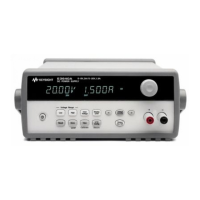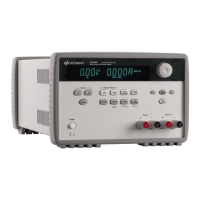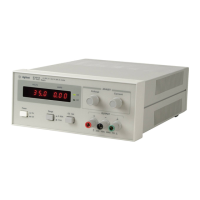Chapter 4 Remote Interface Reference
System-Related Commands
95
4
OUTPut:RELay {OFF | ON}
Set the state of two TTL signals on the RS-232 connector pin 1 and pin 9. These
signals are intended for use with an external relay and relay driver. At *RST, the
OUTPUT:RELay state is OFF. See ‘‘Disconnecting the Output Using an External
Relay’’, on page 59 for more information.
Note Do not use the RS-232 interface if you have configured the power supply to output
relay control signals. Internal components on the RS-232 circuitry may be damaged.
OUTPut:RELay?
Query the state of the TTL relay logic signals.
SYSTem:BEEPer
Issue a single beep immediately.
SYSTem:ERRor?
Query the power supply’s error queue. A record of up to 20 errors is stored in the
power supply’s error queue. Errors are retrieved in first-in-first-out (FIFO) order. The
first error returned is the first error that was stored. When you have read all errors
from the queue, the
ERROR annunciator turns off and the errors are cleared. See
‘‘Error Messages’’, starting on page 125 for more details.
SYSTem:VERSion?
Query the power supply to determine the present SCPI version. The returned value is
of a string in the form YYYY.V where the ‘‘Y’s’’ represent the year of the version,
and the ‘‘V’’ represents a version number for that year (for example, 1997.0).
*IDN?
Read the power supply’s identification string. The power supply returns four fields
separated by commas. The first field is the manufacturer’s name, the second field is
the model number, the third field is not used (always ‘‘0’’), and the fourth field is a
revision code which contains three numbers. The first number is the firmware revision
number for the main power supply processor; the second is for the input/output
processor; and the third is for the front-panel processor.
The command returns a string with the following format (be sure to dimension a string
variable with at least 40 characters):
Agilent Technologies,E3646A,0,X.X-Y.Y-Z.Z (E3646A model)
*TST?
Perform a complete self-test of the power supply. Returns ‘‘0’’ if the self-test passes
or ‘‘1’’ or any non-zero value if it fails. If the self-test fails, an error message is also
generated with additional information on why the test failed.

